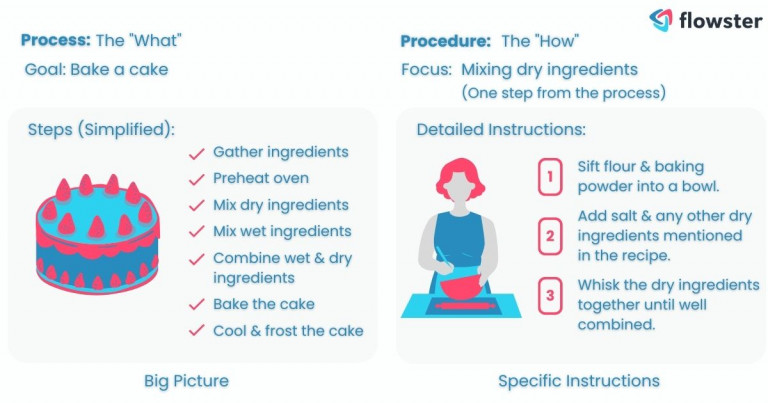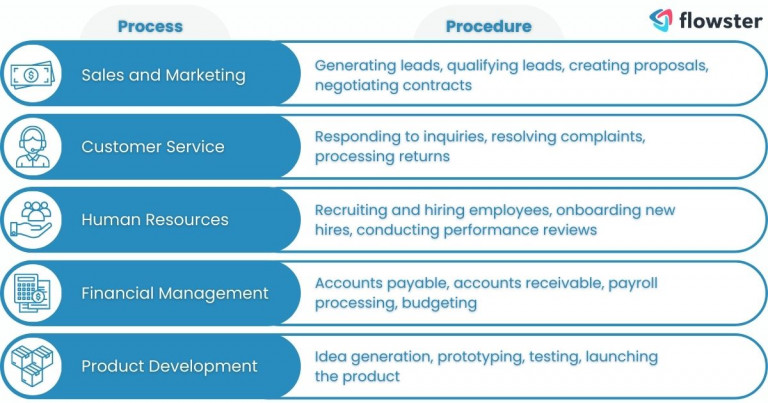Understanding the intricacies of workplace dynamics is pivotal in today’s fast-paced business world. Among these, clearly defined examples of workplace processes and procedures stand out for their ability to streamline operations, enhance productivity, and elevate employee satisfaction. In essence, these frameworks not only safeguard the business’s rhythm but also bolster its capacity to navigate challenges with agility and precision.
Article Outline
What are Processes and Procedures?
At their core, processes and procedures serve as the backbone of organizational functionality, yet they distinctly differ. A process is a collection of steps designed to achieve a specific objective. It’s the blueprint of action, outlining what needs to be accomplished for a goal to be reached.
On the other hand, procedures delve into the nitty-gritty, providing detailed instructions on how each task within the process should be executed. Together, they ensure not just efficiency but also consistency across the board, making business process improvement a continual pursuit for excellence.

Examples of Workplace Processes
In any thriving business, understanding and implementing effective workplace processes is key to efficiency and success. Here, we explore various examples of common and industry-specific processes that underscore their pivotal role in enhancing operational flow and achieving business objectives.
Common Business Processes:
- Sales process: This encompasses everything from lead generation and qualification to crafting proposals and sealing the deal. It’s a fundamental sequence aimed at boosting the sales process’s efficiency.
- Customer service process: handling customer complaints gracefully, fulfilling orders, and managing returns and refunds—are pivotal for maintaining brand reputation and customer satisfaction.
- Hiring process: From reviewing applications to conducting interviews and onboarding, these steps are critical for attracting and retaining top talent. Organizations of all types, including nonprofits, benefit from streamlining these tasks with dedicated tools like hr software for nonprofits, which help simplify hiring workflows and maintain consistency.
- Project management process: This involves planning, executing, monitoring, and closing projects, ensuring that objectives are met efficiently and effectively.
Industry-Specific Processes:
- Healthcare process: In healthcare, processes range from patient encounters to diagnosis, treatment, and follow-up, emphasizing patient care and safety.
- Finance process: The finance sector focuses on invoicing, billing, and managing accounts receivable and payable to ensure smooth global business operations.
- Digital marketing process: processes like SEO, social media marketing, and email marketing are vital for reaching and engaging the target audience in today’s digital age.
Although some businesses require more specialized processes tailored to their industry, maintaining compliance with workplace safety regulations is a universal necessity. For example, in companies handling hazardous materials, proper training is critical to protect employees and meet safety regulations. One of the most important programs for this is the OSHA 40-hour HAZWOPER training, which equips workers with the skills to handle dangerous substances safely. Exploring the osha 40-hour hazwoper training free means businesses can boost workplace safety, stay compliant, and safeguard their employees at no cost.
As we delve into the realm of enhancing business processes, the advent of artificial intelligence (AI) offers transformative potential for automation and efficiency. For an in-depth exploration of how AI can elevate business proficiency, we invite you to read “How Can AI Business Process Automation Improve Business Proficiency?“ Click here.
Transform Your Business with Flowster's AI-Driven Automation
Examples of Workplace Procedures
Delving deeper into the operational fabric of a business, workplace procedures provide the detailed steps necessary for the smooth execution of tasks. This section highlights a variety of administrative and technical procedures critical for maintaining efficiency and ensuring safety within the workplace.
Administrative Procedures:
- Processes for expense reimbursement, time-off requests, and meeting scheduling are essential for smooth administrative operations.
- Data entry procedures are critical for maintaining accuracy and reliability in information management.
Technical Procedures:
- Guidelines on software usage and equipment maintenance are fundamental for operational efficiency and safety.
- Safety protocols, such as fire drills and emergency response procedures, are crucial for ensuring workplace safety procedures.
Interested in diving deeper into the world of standard operating procedures (SOPs) and learning how to craft one for your business? Explore our comprehensive guide, “How to Create SOP in 2024: An Easy Step-by-Step Guide for Your Business,” by clicking here.

Start Creating Workplace Processes and Procedures
The implementation and regular review of workplace processes and procedures are indispensable for any business aiming for success. They not only foster efficient processes and improve business outcomes but also enhance employee morale and compliance with company policies.
As we have explored through various examples of workplace processes and procedures, their significance cannot be overstated. Whether it’s through refining employee conduct, adhering to health and safety procedures, or streamlining the sales process, these structured approaches provide a roadmap to operational excellence.
Encouraging ongoing business process improvement and the adaptation of implementing workplace policies is key. For businesses looking to stay competitive and agile, investing time in creating workplace processes and procedures tailored to their unique needs and goals is a step toward sustainable growth and success.
Problems writing your workplace processes and procedures?
With Flowster, you can easily create your workplace processes and procedures using AI, or you can browse our pre-built templates in the Flowster Marketplace.
Do you need assistance? Use our “Done for You” services to have our quality and improvement experts create customized processes and procedures for you.





2 Responses
This post is incredibly insightful! I love the practical examples you provided, especially the section on streamlining communication processes. It’s amazing how small changes can lead to significant efficiency improvements. Looking forward to implementing some of these strategies in my own workplace!
Great insights on streamlining workplace processes! I love the practical examples you provided; they really clarify how to implement these strategies effectively. Looking forward to seeing more content like this in the future!